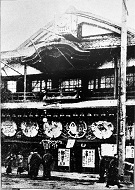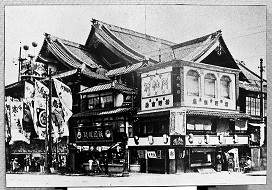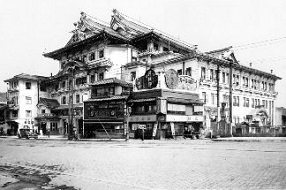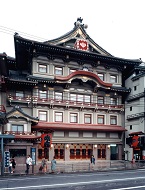Minamiza Theatre

Directions
East side, Shijō-ōhashi-bridge, Higashiyama-ku, Kyoto City
Access
City Bus to "Shijo Kawaramachi"
Hankyu Railways : Kyoto Kawaramachi Station exit 1, 3 min walk
Keihan Railway : Gion -shijō Station exit 6, 1 min walk
JR Kyoto Station : Approx 15 min by Taxi
Floor Map
Seating Chart
Miscellaneous
English Audio Guide:
English Audio Guide may be available depending on the performance.
Box Office
Located on the left side of the main entrance.
Automatic Ticket Dispensers are located next to the Box office and also on Basement Level 1.
Restaurant and Lunch Boxes
Japanese restaurants are located inside the theatre and are open for dining during the intermission (usually 20 - 30 minutes). Reservations are highly recommended. You may also eat and drink at your seats during the intermission.
Japanese Restaurant NADA MAN (Restaurant and Lunch Boxes)
Location:
2nd floor lobby of the Minamiza Theatre.
How to make a reservation:
Please call +81-75-541-1511
Concessions
Drinks, sweets, Kabuki goods, and various Japanese souvenirs are available at the concession stands in the theatre and adjoining facilities!
Izutsu Yatsuhashi Honpo
Location:
1st and 2nd floor lobby of the Minamiza Theatre.
Details:
[1st floor] Sweets and food as souvenirs [2nd floor] Other souvenirs
TORAYA
Location:
1st floor lobby of the Minamiza Theatre.
Details:
Café and sweets as souvenirs
History of Minamiza Theatre
The founding of the Minamiza Theatre goes all the way back to the beginning of the Edo Period (1596-1615). It is said that Izumo no Okuni performed 'kabuki odori' ('kabuki dances') in Kyoto in 1603 which attracted great attention, and during the same period, the dry bed of the Kamo River developed as a 'Theatre town' filled with the bustle and excitement of the people.
The Minamiza Theatre started around this time, and has stood at this place for over 400 years always remaining at the center of entertainment, including kabuki.
In 1906, the theatre came under the management of Shochiku General Partnership Company run by Shirai Matsujirō and Ōtani Takejirō. After some restructuring in 1913, the theatre was remodeled in 1929 as a gabled building in the Momoyama style. Various kinds of performances have been staged there ever since, and the 'Kichirei Kaomise Performance', a kabuki production held every year even during the war, is now known as an annual event in Kyoto.
In 1991, Nagayama Takeomi, the chairman of Shochiku Co,. Ltd, renewed the Minamiza Theatre, making it a modern theatre with the latest technology, but still keeping its historical appearance. It reopened in November, 1991, starting with the 'Kichirei Kaomise Performance'.
The Minamiza Theatre was designated as a Registered Tangible Cultural Property in 1996 and was even registered as a Structure of Historical Design in Kyoto shortly after.
After its large-scale reconstruction to make it earthquake proof, the Minamiza Theatre reopened in November, 2018
While retaining the former theatre's traditional beauty, the new Minamiza Theatre is fitted with the latest stage technology, enabling a wide variety of spectacular effects to be realized. It will stage a wide range of productions throughout the year, from 'traditional Japanese performing arts' to 'the newest live entertainments'.
| 1603 | Izumo no Okuni performs 'kabuki odori' ('kabuki dances') in Kyoto. (Mentioned in 'Tōdaiki'.)  |
|---|---|
| 1608 |
Troupes of women entertainers perform 'Onna Kabuki' ('Female Kabuki') on the dry bed of the Kamo River which becomes popular. (Mentioned in 'Ozuki Takasuke no Sukune Hitsugi') |
| 1614-1615 |
Theatres with yagura towers are constructed, mostly around the dry bed of the Kamo River, and performances of 'Onna Kabuki' and puppets flourish.
This might be the original form of the Minamiza Theatre. (Seen in the 'Rakuchū Rakugaizu Byōbu Funakibon'.) |
| 1601-1620 | The local governor of Kyoto ('Kyōto shoshidai') gives permission for seven theatres to operate to the east of the Kamo River.
(Mentioned in 'Yōshūfushi', 'Hinamikiji' written by Kurokawa Dōyū.) |
| 1624-1644 | Kabuki theatres on the dry bed of the Kamo River flourish.
(Mentioned in 'Tōkaidō Meishoki' written by Asai Ryōi.) |
| 1658 - 1673 | Sounds of the drums are heard from the theatre.
(Mentioned in 'Tōkaidō Meishoki' written by Asai Ryōi.) |
| 1756 | The bustle of the 'Kaomise Performance' is felt.
(Mentioned in 'Zaikyō Nikki' written by Motoori Norinaga.) |
| 1804-1829 | Only theatres to the North and South are left.
(Mentioned in 'Morisada Mankō'.) |
| 1893 | The theatre in the North closes in May and that on the South becomes the only remaining theatre. |
| 1906 | The Minamiza Theatre (in the South) comes under the management of the Shochiku General Partnership Company |
| 1913 | The Minamiza Theatre is completely reconstructed in November. The 'Kichirei Kaomise Production' is held in December and from this time the practice of having actors perform together from both the east and west of Japan is established.  |
| 1929 | The Minamiza Theatre is reconstructed. |
| 1990 | After the performance in February, the Minamiza Theatre undergoes large-scale reconstruction. |
| 1991 | It reopens in October. |
| 1996 | The building is designated as a Registered Tangible Cultural Property |
| 2018 | The reopening of the Minamiza Theatre takes place in November, 400 years since the opening of the first Minamiza Theatre. |

